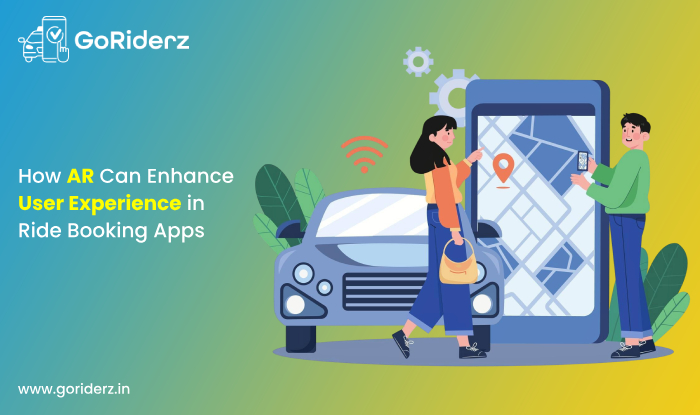
How AR Can Enhance User Experience in Ride Booking Apps?
Table of Contents
Augmented reality (AR) makes ride booking apps easier and more engaging by overlaying digital information on real-world views through a phone’s camera. It helps with pickups, navigation, and even adds interactive features while waiting.
In ride booking app development, AR turns simple trips into experiences that feel safer and more personal.
What is augmented reality in ride booking apps?
AR combines digital elements with the real environment you see around you. In ride booking apps, this could be arrows guiding you to your driver’s car or markers showing safe pickup points.
This fits naturally into taxi booking app development in the USA. It helps solve common problems such as confusion during pickups or long waits.
Apps like Uber already test AR for pickups. A virtual marker appears on your screen, making it easy to spot your driver.
How does AR help with pickups and drop-offs?
Pickups in busy areas can be stressful. AR changes this.
- Your camera view shows a glowing marker where the driver is waiting. No guessing.
- For drop-offs, AR highlights safe spots or building entrances, cutting down delays and frustration.
In ride booking app development, AR features here improve user satisfaction and loyalty. Drivers benefit too, AR shows passenger locations more clearly, helping them reach faster.
What role does AR play in navigation?
Navigation becomes more direct with AR.
- Instead of only viewing maps, users see arrows on the real road through their phone as they walk to the pickup point.
- Drivers see routes projected clearly with highlights for turns or hazards.
This trend in taxi booking app development means fewer missed turns and smoother rides. AR can also show nearby spots or traffic conditions in real time, keeping users engaged.
How does AR add to safety in rides?
Safety is a priority in ride sharing. AR supports it in many ways:
- Drivers receive alerts about pedestrians or cyclists on their route.
- Riders can use AR to check if the vehicle details match the app before entering.
- AR monitoring helps flag potential issues during rides.
- Drivers may receive gentle alerts through AR when signs of fatigue appear.
In ride booking app development, these features build stronger trust between drivers and users.
What personal touches does AR bring to rides?
AR adds thoughtful extras to trips:
- While waiting, users can see route updates, fun facts, or quick activities.
- AR can preview destinations, such as showing a restaurant’s entrance.
- Based on past rides, apps can suggest AR features that feel personalized.
In taxi booking app development, these touches make waiting less boring and rides more enjoyable.
What trends are shaping AR in ride booking for 2025?
AR adoption is growing quickly in the USA and worldwide. Some key stats for 2025:
- Mobile AR users reach 1.07 billion globally (Statista).
- The mobile AR market grows to USD 49.59 billion (Precedence Research, 2025).
- The global ride sharing market is expected to expand to USD 96.9 billion by 2030 (Grand View Research).
- Mobile AR adoption grows at 31.3% CAGR (Global Market Insights).
- Ride sharing revenue reaches USD 156 billion (Business Research Company, 2025).
These numbers highlight AR’s strong growth. In ride booking app development, companies are adding AR to improve engagement.
Future trends include AR pairing with electric vehicles for live battery information and combining with AI for smarter predictions. Users increasingly expect apps to feel modern, and AR meets that demand.
What challenges come with adding AR to apps?
Adding AR features is not always simple.
- Phones need good cameras and sensors, which not all devices have.
- Development costs can be higher, so starting small makes sense.
- Privacy concerns matter, as AR uses live camera data.
- Real-world testing is essential, since lighting and crowded places can affect performance.
- Regular updates are needed as technology advances quickly.
In taxi booking app development, careful planning is key to make AR work well.
How can businesses get started with AR in their apps?
Start with user needs in mind.
- Add AR features that solve real issues, such as pickups.
- Work with developers experienced in AR tools.
- Test early with real users for feedback.
- Expand features gradually as adoption grows.
This step-by-step approach makes AR adoption smoother and more effective.
Conclusion
AR is shaping the future of ride booking apps in the USA. It addresses pain points like tricky pickups, long waits, and safety concerns, while also adding enjoyable extras.
In 2025, ride booking apps without AR may fall behind competitors. Adding AR is not just about technology, it is about creating rides that feel smoother, safer, and more engaging.
If you want to bring AR to your ride booking app, contact us today. Together, we can build an app that riders and drivers appreciate.
FAQs
- Is AR hard to add to existing ride apps?
No, many tools make it easier now. You can begin with basic features like simple overlays and expand later.
- Which ride apps already use AR features?
Uber has tested AR for pickups, while others such as Lyft are trying it for navigation.
- Does AR drain phone batteries fast?
Modern AR is optimized to reduce heavy power use, though users should still keep devices charged during long rides.
- Can AR work offline in ride apps?
Most AR needs data, but some cached map overlays can work offline in limited ways.
- How much does AR increase app downloads?
Studies show AR features improve user engagement by up to 30%, which often leads to more downloads.